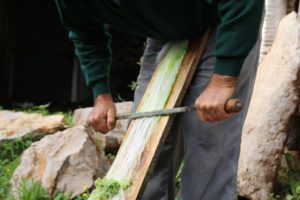Pita Labour
João Florêncio Nunes Barros was born in Peral on June 23, 1938, in the municipality of São Brás de Alportel. He did his first years of schooling at the Mesquita school. From an early age he worked in agriculture, road building, served masons and dug wells.
Even as a child he had learned the art of the Pita labour (“empreita”). Afterwards, they taught him how to work esparto. Later, João Florêncio learned how to rip pita with some neighbors who used this raw material to manufacture ropes used in agricultural tasks. Now retired, he promotes his craft work at fairs and markets, although the greatest pleasure he feels comes from the recognition and admiration of family, neighbors and friends.
Pita (American agave), also known as agave, is an almost stemless plant, with convex and succulent leaves. It appears spontaneously on the side of roads and paths and is still used today for the production of fibers for the manufacture of ropes and tethers, in addition to some medicinal applications. The artisanal work is made from the “thread of the pita”. The process of extracting the fiber from the pita is usually done in the summer. It consists of placing the sheet on a wooden board and, holding one end, the pulp is scraped off with a “scraper” until only the fibers useful for craft work remain.


